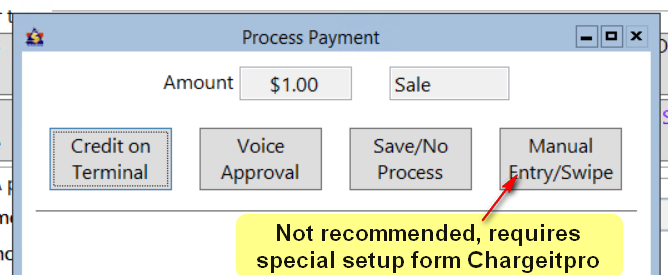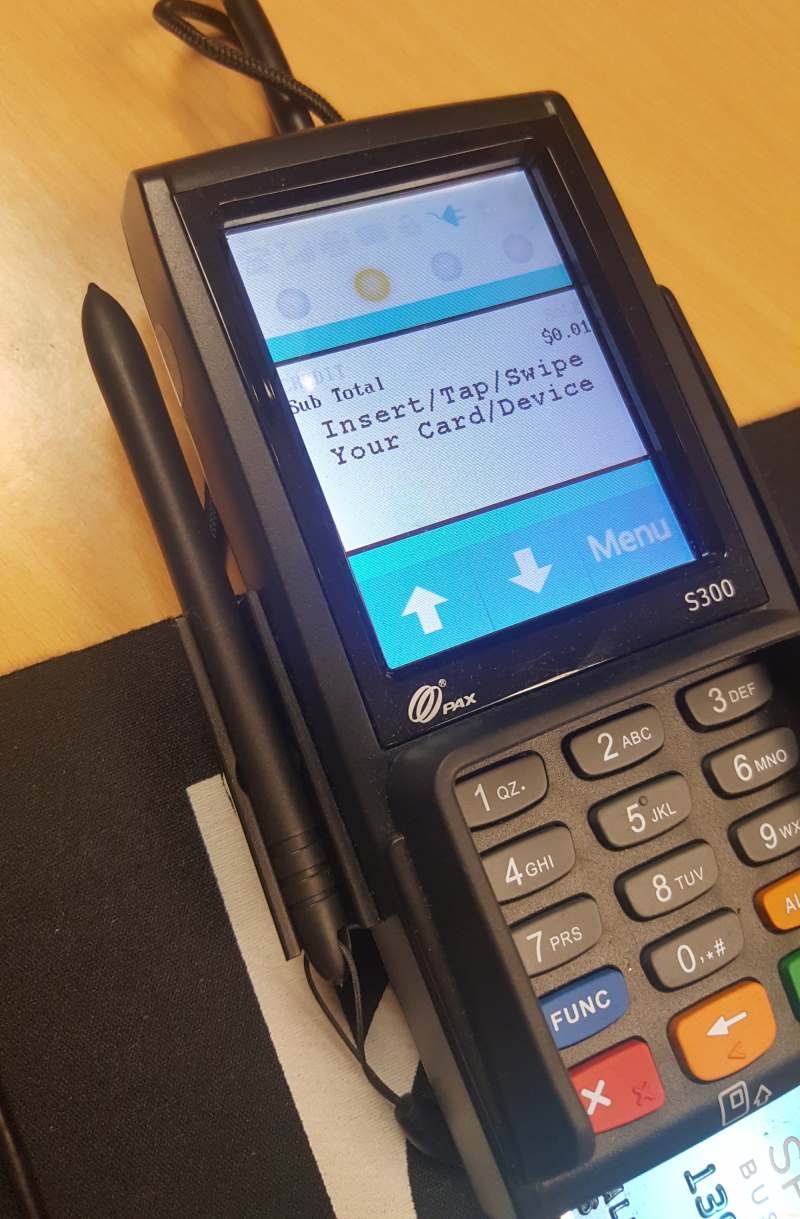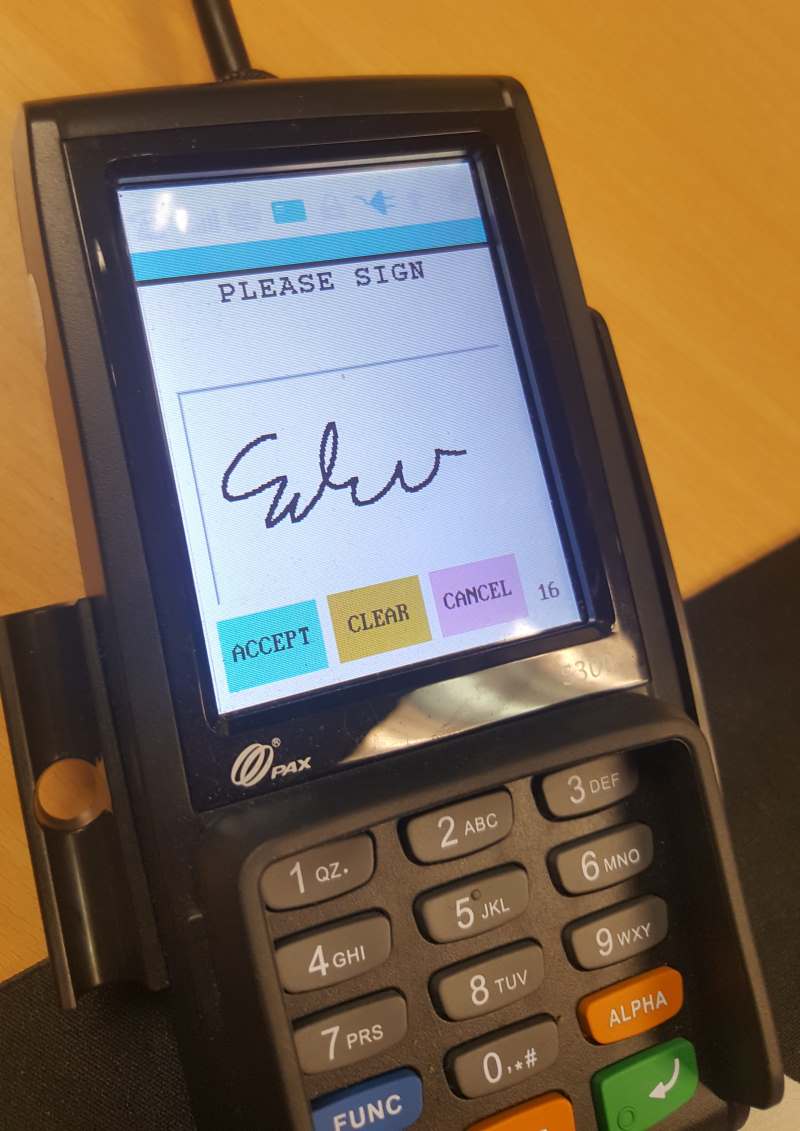ChargeItPro Credit Card Form
Overview
A store receives the lowest cost processing fee when a credit card is swiped thru a hardware credit card swipe. The is considered a qualified credit card. Cards that are manually keyed in will result in the business being charged the most expensive credit card processing fee. Utilizing payment terminals makes the shop 100% PCI Compliant.
When businesses receive alot of call in credit card payments the credit card bank processor may required the business to enter the customer’s billing information, i.e. street address & zip and card’s CVV/CWV code as a security measure. When this is done the processor fee will improve, but still not be as good as a qualified card.
Some situations may arise where the communications to the credit card company is unavailable, but yet the shop still must take credit card payments. This is handled via a phone call and the receipt of a verbal approval from the card processing company. The processor's phone agent will provide the shop consultant with a 'Voice approval code' and this code must be typed into this form. This is considered a FORCE or MANUAL entry.
Chargeitpro/Gravity will provide two online Portals for reviewing all transaction types processed. One Portal is for the ChargeitPro gateway software that the ProfitSystem is communicating and shows the transactions handled. The other Portal is for the Processor company assigned to your shop and this Portal has all the transactions it has processed including voice authorizations and chargebacks. Both should be used for reconciling charges shown in ProfitSystem. Those in the Processor gateway are the ones that is actually being funded or credited. If there is ever a question on a charge, always check the portals for confirmation. In most cases the Gateway and Processor portal should contain the same transactions. But occasionally they may differ. The Processor Portal is the one directly showing transactions affecting the funding to the bank account.
Payment Form
With ChargeitPro is properly configured in ProfitSystem, the payment form will provide a button labeled Credt/Debit/Chip-Pin

Upon choosing this option the electronic payment options appear.
Payments with ChargeitPro
The types of Electronic Payment types supported are:
1) CC Terminal Charges with Chip, Debit, Apple/Android Pay (NFC) or with previously saved card
2) Voids/Credits via CC terminal or previously saved cards/transactions
3) Manual Keyed cards on Terminal
4) Manual Keyed cards with ProfitSystem (optional, must be requested of ChargeitPro)
The ChargeItPro Process Payment form is displayed when:
1) Credit/Debit is selected from the Payments form
2) Ticket->Payments form -> Credit/Debit is selected
3) Ticket-> Highlight existing Charge Payment transaction -> Adjust/Cancel
4) Ticket -> Refund (customer must have store credit or negative ticket balance for REFUND to be active)
The four electronic transaction types ProfitSystem accepts are: 1) SALE - receiving money from a customer 2) CREDIT - Giving money to a customer 3) VOID - Reversing a SALE transaction, making it never show up on a customer's statement 4) SAVING - Saving a customer's credit card information
With ChargeITPro, the card type does not need to be selected, the card type is set automatically from the credit card terminal.
Charge Form SALE- Taking money/charge

Charge Form CREDIT - Returning money/credit
Using the Credit on Terminal option is best and most popular option, as the terminal handles the entire charge process. The ProfitSystem is not involved in the charge, and never has access to the card details. This is the preferred option for charges. When selecting Credit on Terminal activates the terminal to interact with the customer, preventing shop clerks or your computer network having to handle sensitive credit card information.
Manual keyed in charges may be processed on the credit card terminal. Choose Credit on Terminal option, same process as any other charge. This is preferred over keyed credit card information within ProfitSystem. The process is identical but on terminal. Instead of a swipe or chip, the store clerk begins typing the credit card number using the terminals numbered keypad. The manual entry credit card fields will automatically appear. As the data is entered, press the accept arrow key on terminal to have the next field appear. The terminal will prompt for card number, expiration, CCV, billing address and billing zip code. Once all is entered the terminal will report Approved or Declined.
VOIDing a SALE charge transaction
Scenarios arise where a accidental amount or card type was processed for a charge. In this case the store may wish to VOID the ChargeitPro payment. There are only a few minutes after the original charge was processed when this could be accomplished, since the transactions are quickly moved from the ChargeitPro gateway to the processor.
To attempt a VOID, go to the customer's ticket, click on the Payment Charge transaction line within the ticket GRID, then click the ADJUST/CANCEL ProfitSystem transaction type button. The system will display the message:
Upon clicking OK, the ProfitSystem will automatically attempt to VOID the transaction. If successful a success message will appear. Otherwise a CREDIT charge page may appear.
Buttons
Credit on Terminal...This button is available if a Lane is configured in Register Setup for the workstation/tablet being used. This means that an actual credit card terminal is present. This button will activate the terminal to complete the transaction. If the transaction is completed on the terminal, then the approval code will be saved to the ticket payment transaction automatically.


Voice Approval...This is the industry standard processing for processing a Voice authorization. This function will push the approval through the CC terminal to the Gateway then your processor.
The steps are: 1) Call the processor to acquire a Voice approval 2) Be prepared to provide the Merchant Account number, Credit Card number, expiration date and purchase amount. Possibly the CCV code and customer address information as well. 3) A authorization code will be provided on an approval. 4) Select this option Voice Approval and enter the authorization code given. This will then process via the ChargeitPro gateway. 5) A successful Confirmation message should appear. If not check the Chargeitpro Gateway Portal or call ChargeitPro tech support.
Save/No Process... This rarely used option is designed to create/add a credit card payment to the customer's receipt. This option prompts for an optional approval code (the field could be used a a note instead) which is stored with the ticket payment transaction. No processing via the ChargeitPro gateway takes place and thus not record would be found within the Gateway transaction portal, unless it was somehow manually entered within the gateway.
Optional Selections
The options Enter Card/Swipe Card described below must be configured for use by ChargeitPro and do not appear until the options are configured. Contact ChargeitPro tech support for assistance. In General Setup-> Stores -> Credit Card Tab, the enable keyed transactions must also be checked to process cards with ProfitSystem, bypassing the credit card terminal after contacting ChargeitPro to enable this non CC Terminal use within their gateways.
Enter Card and Exp ...This option allows the user to manually enter the card number and expiration date which puts the shop into PCI scope is is less secure that using the CC terminal. Once card details are entered, click the Process button. This would be used when a customer calls in their credit card, for example. The charged is processed a normal thru the ChargeitPro gateway.
Swipe Card Here...Allows the credit card to be swiped on an un-encrypted keyboard swipe connected to the computer. The card number and exp date are extracted from the swipe and inserted into the form. Click the Process button to actually process the charge. This would be used if a terminal is not available, but is still process thru the ChargeitPro gateway.
Enter Card and Exp and Swipe Card Here both allow the card # to pass through the computer and keyboard, which is less secure than the use of a CC terminal.
Acct#, Exp Date...The credit card account number and expiration date. If you are swiping the card, this is filled in automatically. The expiration date in 4 digits. Two for month and two for year, i.e. May 2010 would be entered 05/10. The operator may manually enter the number and expiration as well.
Amount...The amount to charge. This is filled in automatically from the payments form. Name on Card…The name on the card.
Address…The card’s billing address. The street number is all that is needed. Zip code…The card’s billing address zip code.
CVV/CW2…These are three digits on the back of the credit card. Ask your bank processor for more information on the location of these numbers.
Voice approval code...When the operator calls the processor to receive a voice approval and code, the operator would then manually enter the approval code here.
Saving Credit Card Info is Automatic via the CC Terminal...A customer’s credit card information is auto saved in a PCI security compliant environment when any charge is processed thru the Credit Card Terminal. As a result of the automatic saving, the next time a credit card payment is made by this customer, the charge can be completed via their saved details, thus saving time and providing a improved customer service experience. The ability to SAVE credit card information may be disabled from the System/Set-up - Options tab-> 'Don't allow credit card to be saved' option.
SAVED credit card information may also be used for the Payment Plan module.
Credit Card information may be SAVED in four ways.
1) On the Customer form-> Detail Tab-> Add Credit Card
2) Event Form-> Event tab-> Add Credit Card
3) Via this Credit Card form
4) On the Appointment Details form. When processing a charge for a Customer the first time, their credit card info is automatically SAVED, allowing it to be reused for future charges.
Using Saved Credit Card Information
Saved credit card information may be utilized in these two situations, 1) A member of an event is making a Credit Card Payment and the event has a SAVED credit card assigned 2) when the member/customer has a credit card SAVED on their own customer file.
When either of these two scenarios exists the Saved Credit Card Message Selection Box will be displayed and request the user to choose an option.
Saved Card Options
The Use Saved Credit Card form appears immediately upon the User clicking the Credt/Debit/Chip-Pin payment button on the Payment form when saved cards are on file with ChargeitPro.
A message displays: 'Customer Name' has a credit card ending with XXXX saved. Use Customer Card button... click this button to use the saved Customer card info for the charge.
'Event Name' has a credit card ending with XXXX saved. Use Event Card button... click this button to use the Event's saved card info for the charge
Use A New Card button... click this button to use a new card. Once clicked the normal Credit Card payment form will appear. Entering a New Card will automatically SAVE the card details to that customer, overwriting any other previously saved card. Only 1 card may be saved per customer. Cancel... returns to tender form
Note on Logging: This screen shot has a message of a INI entry being present - Logging Charges. Situations may arise where the payment processing transaction should be logged for later analysis. This can be enabled or disabled from the payment form by pressing a key sequence of Shift-F10 or making a system entry for automatic logging. Normally this should be TURNED OFF.
Funding TIP: Batch Settlement & funding turnaround is controlled by the Chip Terminal & Processor being utilized. Depending on the processor's settlement cutoff time, the each terminal can be programmed to send the final settlement just prior to that cutoff time to receive a 24 business hour deposit for the charge transactions. Missing the processor's cutoff settlement time will result in a 48 business hour settlement time.